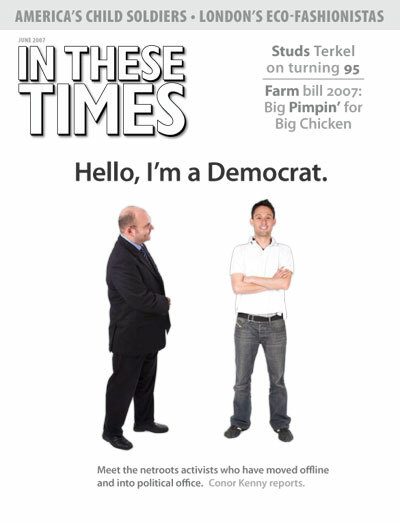Not By Spin Alone
In the battle over reproductive rights, on-the-ground organizing is far more effective than massaging the message
Laura Flanders

Listen to national Democrats and you’d think that when it comes to preserving legal abortion, the answer lies entirely in messaging, framing and spin. Since the Democrats’ defeat in 2004, liberals have invested a mountain of money and time on recasting their message on abortion (among other things). Hillary Clinton now uses her husband’s phrase about keeping abortion “safe, legal, and rare” and takes it one step further, calling abortion “sad, even tragic.” At last month’s Democratic presidential contenders’ debate, Barack Obama cast his pro-choice plan as a commitment to a “culture of life.” Likewise, many women’s groups have gone from talking about liberation and rights to abstractions like “privacy” and “choice.” NARAL (the National Abortion Rights Action League) changed its name to NARAL Pro-Choice America to avoid the nasty word “abortion.” But campaigns aren’t won on spin alone. Just ask the right.
The right has rhetorically outflanked the pro-choice movement, hijacking the words “family” and “life” and “human” to devastating effect. But the “pro-life” activists have outpaced their opponents in other ways too. They’ve cultivated a network of grassroots lobbyists, lawyers and legislators who are successfully advancing their agenda from the state level up. Instead of focusing on framing the issue, Democratic leaders should concentrate on the message that is in the frame, and creating a way to get that message out.
— — — — — — — — — — — –In February 2006, the South Dakota legislature passed an abortion ban, HB 1215, that criminalized abortion in every instance, with no exception for rape or incest, and no exception for a woman’s health. South Dakotans rallied, gathering 38,000 signatures to put what became Referred Law 6 on the ballot. Come November, voters had to vote yes (to uphold Referred Law 6) or no (to repeal it).
The group responsible for the ballot initiative campaign was the South Dakota Campaign for Healthy Families, directed at the time by Lindsay Roitman. Roitman arrived in the state in July, from Seattle, (where she’d worked in the corporate office of Starbucks). She had to move fast to get the lay of the land. Sixty-five percent of South Dakotans live outside of metropolitan areas; communities are scattered, resources are few. When HB 1215 was passed, South Dakota boasted just one statewide women’s organization with a core group of 25 to 50 members. The right-to-life movement, on the other hand, was well established. In state primaries in 2006, right-wing Christians challenged moderate Republicans in 17 races and won every time.
Roitman hired a team to conduct focus groups. “I was taken aback by some of the attitudes we found,” she says. Most of the South Dakotans surveyed opposed abortion, but many agreed that HB 1215 was too extreme. Healthy Families decided to focus their efforts on cities, the non-native population and swing voters. On TV, in campaign literature and in talking points their slogan was: “This Law Simply Goes Too Far.” Asked what would happen if the ban was defeated but its supporters returned with an amended version, with rape or incest exceptions tacked on, Roitman sighed: “I can’t correct years of failure in just four months with $2 million.”
South Dakotans describe a situation not so different from that laid out by Thomas Frank in What’s the Matter with Kansas? As jobs and resources have trickled out, the Christian right and its anti-government allies have poured in. In the last 30 years Theresa Spry, a Lakota grandmother living in the far western part of the state, has seen her hometown, Rapid City, lose jobs, health care centers, quality public schools and money for public services. By the time the backlash movement showed up, it was like a tide flowing onto a bulldozed plain.
Spry worked as family planning counselor “until the environment for that kind of work became too severe,” she told me. “The religious right walked in the door and took over. In one decade, evangelicals took over the school board, the city council, the county commission, the legislature.” HB 1215 wasn’t passed overnight. Indeed, in 2004, Gov. Mike Rounds vetoed a bill that was very similar to HB 1215, but new bills kept on coming.
— — — — — — — — — — — –It’s the same across the country: those on the right and the left don’t only have different political views; they do politics in different ways. The money on the liberal side floods in and out with the election tide, focused on the White House, Congress, the Supreme Court, or, as in the case of South Dakota, emergency campaigns like an all-out abortion ban on the ballot. In terms of support and financing, national organizations pretty much write off pro-choicers in red states, even though they are on the front lines of the anti-abortion fight.
Julie Burkhart, executive director of the Kansas pro-choice group KANDO, told me: “If we’re going to take this issue away from the Right, we have to do it now and do it methodically and think about the future. … What we need are leaders who’ll stand on principle, leaders who’ll stand up.”
And such leaders are needed at the local as well as the national level. Barbara Santee, retired executive director of NARAL Pro-Choice Oklahoma, had to close her organization’s doors a few years back because so little trickled down from the national office. “They were keeping their money for federal races and they just gave up on us because we are in a red state,” she says. “Which made us blue state people purple – with rage.”
Victories in such places are not impossible. In the same week this April that the Supreme Court upheld the Partial Birth Abortion Act, organizers in Oklahoma succeeded in defeating a sweeping anti-abortion bill thanks to their local, not national, networks. Locals have the know-how to pull off victories, says Santee. “It’s just so frustrating to live here and not get the help we need.”
Abortion rights groups are not outspent; they gave more than $1.4 million in the 2004 election to candidates for national office. In addition, Emily’s List raised $2.5 million in 2006 for female candidates who support abortion rights. The National Right to Life Committee, the largest electoral outfit on the criminalization side, raised and spent only about $1.7 million in 2006. But the opponents of abortion rights sow their grassroots year-round through their networks of right-wing churches and state-based women’s organizations, including Eagle Forum and Concerned Women for America.
As one pro-choice organizer told me, “We’ve gotten very good at mobilizing our members – mowing our grassroots while the other side keeps sowing sod.”
The conversation about abortion needs to change, but the top-down message strategy is only a tiny piece of a much larger problem. Lynn Paltrow, founding director of National Pregnant Women’s Advocates, puts it this way: “For a long time, most of our organizations have done a terrific job focusing inside the courts – once a bill is passed, they’re right there to challenge it. But the intrepid grassroots activists are out there on their own.”
Across the board, women of color are the poorest and have the least access to health services, yet they are ignored by the national advocacy networks. Language is important, says Eveline Shen of Asian Communities for Reproductive Justice in the Bay Area, but having authentic networks and credibility is more important: “The Democrats and the reproductive rights movement can say whatever they like, but if they don’t have the connections to the communities, it’ll make no difference.”
The same goes for young women. Kierra Johnson, development director of the young women’s group, CHOICE USA, told me, “Those who are the most threatened are the most likely to fight. It’s absurd to leave them on the sidelines.”
Paltrow puts it this way: “The way we talk about things does matter, and it matters because you can either inspire or not, convert or not, motivate or not.”
— — — — — — — — — — — –Reproductive rights have been eroding in South Dakota for years. Even before the no-exceptions abortion ban, South Dakota granted full legal status to the fetus and imposed all manner of restrictions on women seeking to abort. HB 1215 was one of five bills passed in 2005 and 2006 that restricted abortion, including the one that requires doctors to tell women that abortion ends the “life of a whole, separate, unique living human being.”
I asked Theresa Spry, “What was happening on the other side during all this time?” She replied, “What other side?”
The Democratic establishment of South Dakota has been cowed. In 1992, state Democrats dropped from their platform any commitment to a woman’s right to choose. In 2006, six out of 10 Democrats in the state senate and seven out of 19 in the house voted for the no-exceptions abortion ban. During the party conventions that year, Republicans made abortion a central theme of the race and conservative advocacy groups pledged their help in dollars and volunteers. Democratic state leaders, on the other hand, discouraged candidates from making abortion an issue and approached the midterm elections in a decidedly low-key manner. The one independent pro-choice advocate – Kate Looby, South Dakota director for Planned Parenthood – was asked to leave the state party convention.
In the end, the South Dakota abortion ban was defeated, but the legislators who voted for it were not. The anti-choicers hold as much power as ever. Theresa Spry ran for the state senate in 2006, winning a four-way primary, but she was defeated in the general election by Bill Napoli, a backer of the ban who, when asked under what circumstances abortion might be permissible, babbled something about a raped Christian virgin who was “brutalized and raped, sodomized as bad as you possibly make it and impregnated.” Clearly, Napoli’s not too bothered about cautious “spin.”
Spry has run for office before, and says she’ll do it again. It’s not just the law, it’s the legislature, that has to change. “We can’t give up. We just need a long-term plan,” she says. “There’s a long term plan on the other side. What’s ours?”
This essay is adapted from Blue Grit: True Democrats Take Back Politics from the Politicians (Penguin Press.







